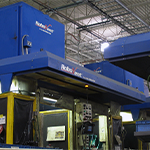Kubota Manufacturing: A Proactive Solution for Worker Safety
Featured Solution: Senturion
Industries: Heavy Equipment
Applications: Robotic Welding
The Kubota Manufacturing of America Corporation is located in Gainesville, Ga., and employees 1,100 people who make lawn/ garden and utility tractor frames, utility vehicle frames and mower decks.

The Gainesville plant opened in 1988, and while there have been no complaints or violations about the air quality or the air filtration system, Kubota took a pro-active stance in improving the working environment for the comfort and safety of its employees.
While the company has always been compliant with air quality levels and performed air testing every year, a smoky haze still hung in the weld shop. Being “just” compliant wasn't enough for Kubota. Kubota decided to investigate additional air filtration options.
Dustin Payne is the manager of Maintenance Facilities and Environmental for Kubota and has the responsibility for the day-to-day maintenance of the entire facility, the machines used to build the equipment, as well as the oversight of environmental compliance.
Starting with Internet research, Payne began to narrow down the venting companies with which he wanted to talk. System durability and fire suppression were key factors in deciding which companies Kubota would bring in to discuss its needs in more detail.
“I knew we would frequently move the venting system around the shop floor,” said Payne. “Durability was critical in our decision of which company to work with. In addition, we wanted a reliable automatic fire-suppression system for safety.”
In addition to Kubota's requirements for the new venting system, the company wanted a system tailor-made for their existing robotic welding cells.
“It just made sense that if there was a system that could be designed around our needs, we needed to take advantage of it,” said Payne. “Especially since we needed a flexible air filtration system that would make layout changes easier to implement.”
Kubota chose the RoboVent Floorsaver and FlexMount air-filtration systems manufactured by RoboVent Product Group, Inc. of Clawson, Michigan, for all of its welding cells.
“We chose the RoboVent system because the company could design something specifically to fit our robotic welding cells,” Payne said. “Flexibility and safety were big concerns for our facilities, and RoboVent addressed both issues.”
In addition to the Internet research, Kubota spoke with customers for each of the vendors they were considering for this project.
“In addition to the RoboVent system being very robust and easy to maintain, we found that all the RoboVent customers had good things to say about the system and the support of RoboVent in working on any issues,” said Payne. “That really made us comfortable in our decision to select RoboVent.”
RoboVent worked around Kubota's schedule when installing the venting system. The company's flexibility allowed Kubota to continue operating its two shifts while the system was installed. Productivity was never an issue during installation.
The over-cell design Kubota chose minimized consumption of floor space and eased facility layout changes. Anything else would have been a waste of space and not very efficient, according to Payne.
RoboVent FloorSaver air-filtration units mount directly on the top of the welding cell, use no ductwork and can be moved with the cell. The RoboVent captures virtually all of welding smoke and fumes as they are produced, as well as filters and cleans the air, and returns the clean air to the plant.
The RoboVent units at Kubota utilize a hood that is mounted over the welding cell. The hood includes RoboVent's SparkOut System, a specially engineered spark arrestance system that prevents fires as it sucks air laden with smoke, welding dust and airborne particulates from the welding cell. The air travels through a duct to a self-contained collection and filtering unit that sits on the floor next to the welding cell. The collection unit consists of a housing blower, motor, silencer, filter cartridges and a unique compressed air-pulsing system to clean the filters.
The RoboVent collection unit uses a patented filtration process in which air flows in a downward path. This is unique to the RoboVent product and provides more efficient air cleaning. The RoboVent PowerFlex system is a proprietary filter cleaning system to keep filters clean and extend filter life.
“It is important to Kubota to protect our employees and to maintain the healthiest environment possible,” said Payne. “For health and efficiency reasons, we can't even imagine going back to a system without welding hoods.”
The RoboVent units use vertical filters, which are more efficient and have a much longer filter life than the horizontal filters used in most air filtration units. Vertical filters allow collected dust and debris to shed off the filter and fall directly down (with the direction of the RoboVent's airflow) into the containment or collection tray when the filters are pulsed by the filter cleaning system.
Using horizontal filters is very inefficient, according to John Reid, president of RoboVent Product Group, Inc.
“We've found that dirt and debris tends to build up on the top third of a horizontal filter, rendering the top of the filter ineffective as it becomes clogged with debris,” he said. “This results in a 30 to 40 percent loss in filter area and a substantial reduction in filter life.”
“We worked closely with RoboVent in designing and constructing our system,” said Payne. “They have been responsive, and their customer service is excellent. I think any company would benefit from RoboVent's flexibility, as well as their desire to produce a system that meets the needs of each customer.”





